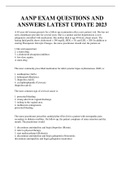Exam (elaborations)
AANP ACTUAL EXAM QUESTIONS AND ANSWERS LATEST UPDATE 2024
- Course
- Institution
AANP EXAM QUESTIONS AND 100% GUARANTEE PASS ANSWERS LATEST UPDATE 2023 AANP EXAM QUESTIONS AND ANSWERS LATEST UPDATE 2023 A 65-year-old woman presents for a follow-up examination after a new patient visit. She has not seen a healthcare provider for several years. She is a smoker and her hyper...
[Show more]




